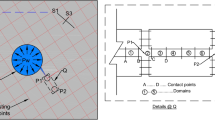Abstract
Internal pressure tunnels and wells that are mainly used to transfer water from dam reservoirs to electrical power plants in rivers downstream are considered among the power plant’s permanent facilities. In order to design reinforced concrete structures in these tunnels, recognizing the concrete lining behavior and interaction between rock mass and concrete and also the effect of internal pressure on the concrete shell and rock mass is of great significance. One of the important and effective issues in inner lining forces is their filler type. In this paper, using the finite difference method by the FLAC software, the analysis of Sardasht dam water tunnel which has been filled with mineral pumice in falling zones has been carried out. Results indicate that by increasing the falling zone thickness while the lining is porous or non-porous, the inner forces are decreased.
Similar content being viewed by others

References
Arjnoi, P., Jeong, J., Kim, C., and Park, K., Effect of Drainage Conditions on Porewater Pressure Distributions and Lining Stresses in Drained Tunnels, Tunneling and Underground Space Technology, 2008. Available at: www.elsevier.com/locate/tust.
Bobet, A. and Nam, S.W., Stresses around Pressure Tunnels with Semi-permeable Liners, Int. J. Rock Mech. Rock Engng., 2007, 40; 287–315.
Tani, El, M., Circular Tunnel in a Semi-Infinite Aquifer, Tunneling and Underground Space Technology, 2003, 18(1), 49–55.
ASCE, Civil Engineering Guidelines for Planning and Designing Hydroelectric Development, 1989, vol. 2.
Schleiss, A.J., Design of Reinforced Concrete Linings of Pressure Tunnels and Shafts, Hydropower and Dams, 1997, vol. 3, pp 88–94.
Li, Y. and Lence, B.J., Estimating Resilience for Water Resources Systems, Water Resour. Res., 2007, 43, W07422.
Wang, T.T., Characterizing Crack Patterns on Tunnel Linings Associated with Shear Deformation Induced by Instability of Neighboring Slopes, Eng. Geol., 2010, 115, 80–95.
Ni, J.C. and Cheng, W.C., Characterizing the Failure Pattern of a Station Box of Taipei Rapid Transit System (TRTS) and Its Rehabilitation, Tunnel. Under. Space. Technol., 2012, 32, 260–272.
Choi, S.W., Lee, J., and Chang, S.H., A Holistic Numerical Approach to Simulating the Thermal and Mechanical Behavior of a Tunnel Lining Subject to Fire, Tunn. Undergr. Space Technol., 2013, 35, 122–134.
Huang, H.W., Xu, R., and Zhang, W., Comparative Performance Test of an Inclinometer Wireless Smart Sensor Prototype for Subway Tunnel, Int. J. Architecture Eng. Constr., 2013, 2, 25–34.
Pinto, F. and Whittle, A.J., Ground Movements Due to Shallow Tunnels in Soft Ground. I: Analytical Solutions. J. Geotech. Geoenviron. Eng., 2014, DOI: 10.1061/(ASCE)GT.1943-5606.0000947.
Spyridis P. and Bergmeister K., Analysis of Lateral Openings in Tunnel Linings, Tunneling and Underground Space Technology, 2015, 50; 376–395.
Panthi K.K., Himalayan Rock Mass and Possibility of Limiting Concrete Lined Pressure Tunnel Length in Hydropower Projects in the Himalaya, Geosystem Engineering, 2015, 18, 45–50.
Haeri, H., Marji, M.F., and Shahriar, K., Simulating the Effect of Disc Erosion in TBM Disc Cutters by a Semi-Infinite DDM, Arabian Journal of Geosciences, 2015, vol. 8(6), pp. 3915–3927.
Haeri, H., Propagation Mechanism of Neighboring Cracks in Rock-Like Cylindrical Specimens under Uniaxial Compression, J. Min. Sci., 2015, vol. 51, no. 3, pp. 487–496.
Haeri, H., Khaloo, A., and Marji, M.F., Experimental and Numerical Simulation of the Microcracks Coalescence Mechanism in Rock-Like Materials, Strength of Materials, 2015, vol. 47(1), pp. 740–754.
Haeri, H., Khaloo, A., and Marji, M.F., A Coupled Experimental and Numerical Simulation of Rock Slope Joints Behavior, Arabian Journal of Geosciences, 2015, vol. 8(9), pp. 7297–7308.
Haeri, H., Khaloo, A., and Marji, M.F., Fracture Analyses of Different Pre-Holed Concrete Specimens under Compression, Acta Mechanica Sinica, 2015, vol. 31, pp. 855–870.
Huang, H.-W. and Zhang, D.-M., 2016, Resilience Analysis of Shield Tunnel Lining under Extreme Surcharge: Characterization and Field Application, Tunneling and Underground Space Technology, 2016, vol. 51, pp. 301–312.
Chang, S.-H., Choi, S.-W., and Lee, J., Determination of the Combined Heat Transfer Coefficient to Simulate the Fire-Induced Damage of a Concrete Tunnel Lining under a Severe Fire Condition, 2016, Tunneling and Underground Space Technology, 54, pp. 1–12.
Haeri, H., Experimental and Numerical Study of Crack Propagation in Pre-Cracked Beam Specimens under Three-Point Bending, Journal of Central South University, 2016, vol. 23(4), pp. 430–439.
Sarfarazi, V., Haeri, H., Shemirani, A. B., Zhu, Z., Shear Behavior of Non-Persistent Joint Under High Normal Load, Strength of Materials, vol.41(2), pp. 320–334.
Fernandez, G., Behavior of Pressure Tunnels and Guidelines for Liner Design, Journal of Geotechnical Engineering, 1994, vol.120, pp.1768–1791.
Kolymbas, D. and Wagner, P., Groundwater Ingress to Tunnels—The Exact Analytical Solution, Tunneling and Underground Space Technology, 2007, 22 (1), pp.23–27.
Schleiss, A.J., Design of Pervious Pressure Tunnels, International Water Power and Dam Construction, 1986, 38(5), pp.21–26.
Schleiss, A.J., Design Criteria for Pervious and Unlined Pressure Tunnels, Underground Hydropower Plants, Oslo, 1987, pp. 667–678.
Author information
Authors and Affiliations
Corresponding author
Additional information
The article is published in the original.
Rights and permissions
About this article
Cite this article
Haeri, H., Tavakoli, H., Shemirani, A.B. et al. Evaluating the use of mineral pumice in falling zones of internal pressure tunnels (Case study: Water transfer tunnel of Sardasht dam power plant). J Min Sci 52, 1060–1068 (2016). https://doi.org/10.1134/S106273911606160X
Received:
Published:
Issue Date:
DOI: https://doi.org/10.1134/S106273911606160X



